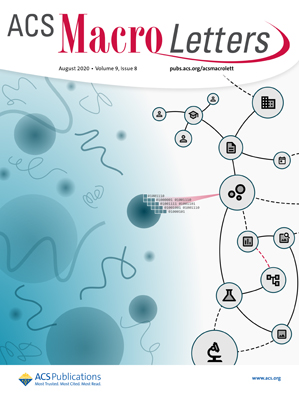Viscosity-Controlled Thiol-Ene Reaction and Its Impact on Mechanical Response of Dynamic Networks.
IF 5.1
Q1 POLYMER SCIENCE
引用次数: 0
Abstract
The impact of curing conditions on the final properties of thioester-thiol-based dynamic polymer networks was systematically investigated. Despite identical monomer and cross-linker compositions, networks synthesized in the absence of solvent exhibited significantly higher shear moduli and longer relaxation times compared to those cured in solvent. These differences arise from viscosity-controlled photoinitiated thiol-ene reactions, where reduced chain mobility under solvent-free conditions suppresses termination between two polymer radicals, leading to higher reaction conversion. Fourier Transform Infrared (FTIR) spectroscopy and solid-state NMR (ssNMR) spectroscopy confirmed a greater degree of "click" reaction completion in higher viscosity environments. Control experiments revealed that prolonged radical lifetimes and suppressed termination reactions under solvent-free curing conditions contribute to these variations. This study highlights the crucial role of processing conditions in determining cross-link density and, consequently, the dynamic mechanical behavior of polymer networks. It demonstrates that, beyond polymer chemistry, dynamic cross-linker design, and phase separation, curing conditions serve as a key design parameter for tailoring material performance to specific applications.粘度控制的硫醇-烯反应及其对动态网络力学响应的影响。
系统地研究了固化条件对硫酯-巯基动态聚合物网络最终性能的影响。尽管单体和交联剂组成相同,但与在溶剂中固化的网络相比,在没有溶剂的情况下合成的网络表现出更高的剪切模量和更长的弛豫时间。这些差异源于粘度控制的光引发的硫醇反应,在无溶剂条件下,链迁移率降低抑制了两个聚合物自由基之间的终止,导致更高的反应转化率。傅里叶变换红外(FTIR)光谱和固态核磁共振(ssNMR)光谱证实,在高粘度环境中,“咔嗒”反应完成程度更高。对照实验表明,在无溶剂固化条件下,自由基寿命延长和终止反应抑制是导致这些变化的原因。这项研究强调了加工条件在决定交联密度和聚合物网络动态力学行为方面的关键作用。这表明,除了聚合物化学、动态交联剂设计和相分离之外,固化条件也是定制材料性能以适应特定应用的关键设计参数。
本文章由计算机程序翻译,如有差异,请以英文原文为准。
求助全文
约1分钟内获得全文
求助全文
来源期刊
CiteScore
10.40
自引率
3.40%
发文量
209
审稿时长
1 months
期刊介绍:
ACS Macro Letters publishes research in all areas of contemporary soft matter science in which macromolecules play a key role, including nanotechnology, self-assembly, supramolecular chemistry, biomaterials, energy generation and storage, and renewable/sustainable materials. Submissions to ACS Macro Letters should justify clearly the rapid disclosure of the key elements of the study. The scope of the journal includes high-impact research of broad interest in all areas of polymer science and engineering, including cross-disciplinary research that interfaces with polymer science.
With the launch of ACS Macro Letters, all Communications that were formerly published in Macromolecules and Biomacromolecules will be published as Letters in ACS Macro Letters.

 求助内容:
求助内容: 应助结果提醒方式:
应助结果提醒方式:


